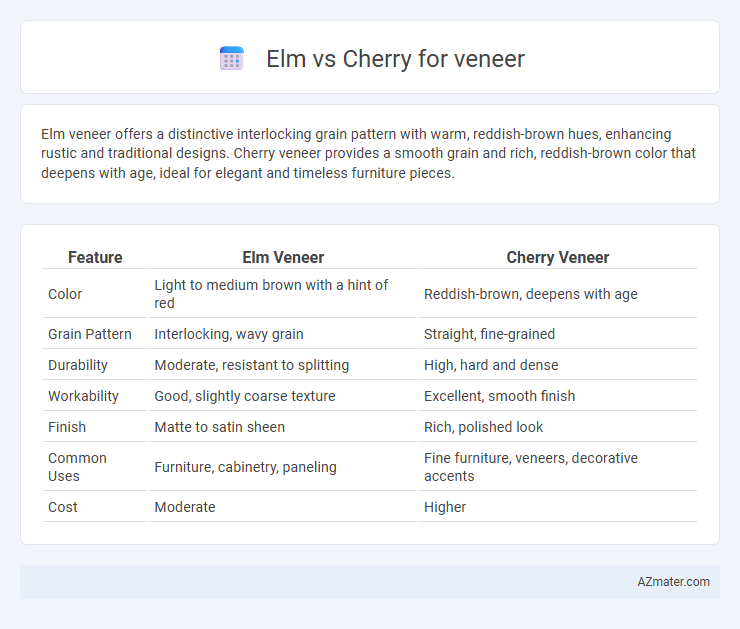Elm veneer offers a distinctive interlocking grain pattern with warm, reddish-brown hues, enhancing rustic and traditional designs. Cherry veneer provides a smooth grain and rich, reddish-brown color that deepens with age, ideal for elegant and timeless furniture pieces.
Table of Comparison
| Feature | Elm Veneer | Cherry Veneer |
|---|---|---|
| Color | Light to medium brown with a hint of red | Reddish-brown, deepens with age |
| Grain Pattern | Interlocking, wavy grain | Straight, fine-grained |
| Durability | Moderate, resistant to splitting | High, hard and dense |
| Workability | Good, slightly coarse texture | Excellent, smooth finish |
| Finish | Matte to satin sheen | Rich, polished look |
| Common Uses | Furniture, cabinetry, paneling | Fine furniture, veneers, decorative accents |
| Cost | Moderate | Higher |
Introduction: Elm vs Cherry Veneer
Elm veneer features a distinctive interlocking grain pattern with a warm golden-brown hue, offering a natural, rustic aesthetic ideal for traditional and craftsman-style furniture. Cherry veneer, known for its smooth texture and rich reddish-brown color, develops a deep patina over time, adding elegance to contemporary and classic designs. Both veneers provide durable, high-quality surfaces, with elm emphasizing unique grain character and cherry valued for its refined, uniform appearance.
Overview of Elm Veneer
Elm veneer showcases a distinctive grain pattern characterized by interlocking, wavy textures that provide visual complexity and durability. Its natural resistance to splitting and strong tensile strength make elm veneer an excellent choice for both decorative surfaces and structural applications. Popular in furniture making and interior design, elm veneer offers warm reddish-brown hues that enhance the aesthetic appeal of various wood projects.
Overview of Cherry Veneer
Cherry veneer is prized for its rich, reddish-brown color that deepens over time, adding warmth and elegance to furniture and cabinetry. Its fine, straight grain and smooth texture provide a luxurious surface that is both visually appealing and easy to work with. Compared to elm, cherry veneer offers superior hardness and durability, making it a preferred choice for high-end wood applications.
Appearance and Grain Patterns
Elm veneer showcases an attractive interlocking grain pattern with swirling, wavy lines that create a dynamic, textured surface ideal for rustic or traditional designs. Cherry veneer features a smooth, fine grain with a consistent, straight pattern and rich, warm reddish-brown hues that deepen over time, making it perfect for elegant, classic furniture. Both woods offer distinct aesthetic qualities; elm's vibrant grain enhances visual complexity, while cherry's uniform grain provides a sleek, polished look.
Color and Aging Characteristics
Elm veneer features a warm, rich brown color with distinctive interlocking grain patterns that deepen and mellow gracefully over time. Cherry veneer displays a smooth, fine grain with a reddish-brown hue that darkens to a rich, reddish patina, enhancing its elegance as it ages. Both woods age beautifully, but Elm tends to develop a more rustic charm, while Cherry offers a consistently smooth and vibrant finish.
Durability and Hardness Comparison
Elm veneer exhibits moderate durability with a Janka hardness rating around 830, making it resistant to wear and suitable for furniture and cabinetry. Cherry veneer, with a Janka hardness of approximately 995, offers higher hardness and better resistance to dents and scratches, ideal for high-traffic areas. Both woods provide good durability, but cherry's superior hardness enhances its longevity and performance in demanding applications.
Workability and Application
Elm veneer offers excellent workability due to its interlocking grain, providing durability and resistance to splitting, making it ideal for furniture and cabinetry requiring curved surfaces or intricate designs. Cherry veneer is prized for its smooth texture and fine grain, allowing easy sanding, staining, and finishing, which suits upscale interior applications like paneling and decorative accents. Both woods perform well in veneer form, but elm's toughness makes it preferable for structural components, while cherry's aesthetic qualities enhance high-end visual appeal.
Cost and Availability
Elm veneer typically offers moderate cost with good availability due to its widespread presence in North America and Europe, making it a practical choice for budget-conscious projects. Cherry veneer tends to be more expensive, reflecting its desirable rich color and fine grain, with moderate availability influenced by supply constraints and sustainability considerations. Choosing between elm and cherry veneer depends largely on balancing budget limits against aesthetic preferences and regional supply conditions.
Best Uses for Elm and Cherry Veneer
Elm veneer is highly valued for its interlocking grain pattern and durability, making it ideal for furniture and paneling that require both strength and decorative appeal. Cherry veneer offers a fine, smooth texture with rich reddish-brown hues that deepen over time, perfect for elegant cabinetry and high-end woodworking projects. Both veneers complement various interior styles; elm excels in rustic and traditional designs, while cherry suits classic and contemporary aesthetics.
Choosing the Right Veneer for Your Project
Elm veneer offers a unique blend of rich, wavy grain patterns and warm, reddish-brown hues, making it ideal for projects requiring distinctive rustic charm and strong visual impact. Cherry veneer provides a smooth, fine-grained texture with a rich, reddish tone that deepens over time, perfect for elegant, classic furniture and cabinetry. Selecting between elm and cherry veneers depends on the desired aesthetic durability, and how the natural grain and color will complement the overall design of your project.

Infographic: Elm vs Cherry for Veneer
 azmater.com
azmater.com